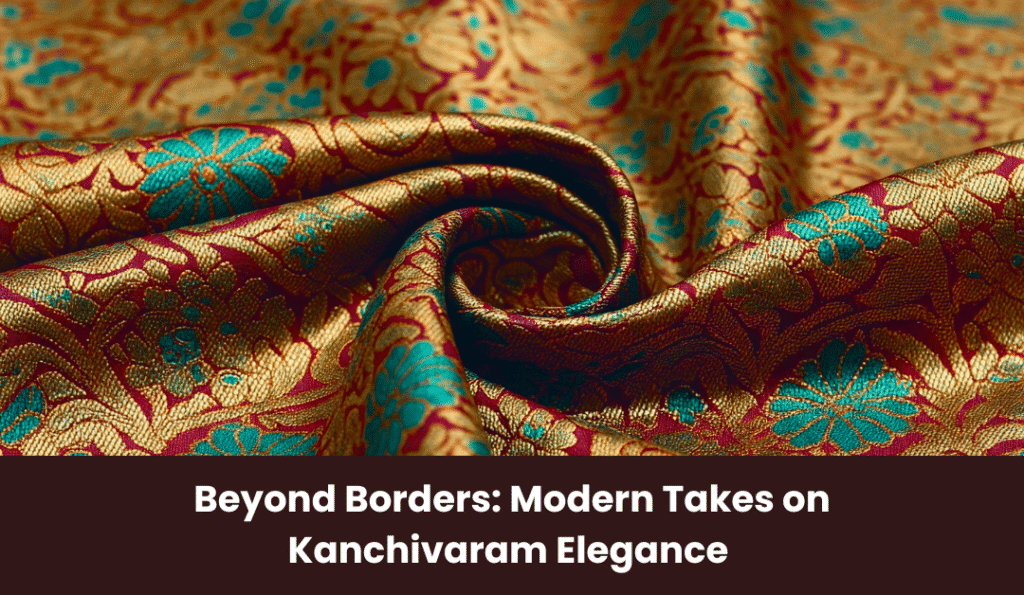There’s something about a Kanchivaram saree that’s hard to put into words. Maybe it’s the way the silk catches the light, like sunlight dancing on temple steps in the late afternoon. Or the way the weight of it rests on your shoulder, steady and reassuring, almost like it knows it’s been part of countless stories before yours. Kanchipuram Silk Sarees have been around for centuries, woven in the temple town of Tamil Nadu, but these days they’re finding themselves far from home , worn at fashion weeks in Paris, destination weddings in Bali, and rooftop dinners in New York.
A tradition with deep roots
If you’ve ever walked through the weaving streets of Kanchipuram, you know it’s not just a town , it’s a rhythm. The clack of wooden looms, the faint smell of dyed silk drying in the sun, aunties haggling over zari patterns in cramped little shops. Every thread is pure mulberry silk, every border lined with gold or silver, and the motifs , peacocks, mangoes, temple gopurams , come straight from centuries,old designs.
These sarees were once strictly festive wear, saved for weddings or major pujas. Your grandmother probably had hers wrapped in soft white cloth, stacked away in a steel almirah, taken out only on special days. But the world has changed, and so has the way we wear them.
Old charm, new vibe
These days, the Kanchivaram isn’t sitting quietly in a cupboard. It’s out there, mixing with the global crowd. Designers are trimming down the heaviness for everyday comfort, replacing bold reds and purples with blush pinks, icy greys, or even powder blues. You’ll find young women wearing them with off,shoulder blouses, chunky sneakers, or even leather belts cinched at the waist. At first glance it sounds like madness, but somehow, it works.
I once saw a friend pair hers with a cropped denim jacket at a gallery opening in Bengaluru. She looked like she belonged in both worlds at once , sipping wine in an art space while wrapped in centuries of tradition.
Weaves meeting wanderlust
The beauty of the Kanchivaram is that it can travel without losing itself. Brides abroad are making it part of multicultural weddings, swapping heavy gold jewelry for minimal silver, or pairing it with veils. Some are wearing it for reception dinners instead of the wedding day itself, letting it shine in its own moment.
Even non,Indian brides are getting curious. Imagine a cream Kanchivaram with subtle gold lines, cut and stitched into a flowing gown. It sounds unusual, but when done right, it’s magic.
The saree’s social media moment
Instagram and Pinterest have given the Kanchivaram a second wind. Short reels show weavers at work, their hands moving so quickly you can barely keep track. Influencers post “how to drape” videos with twists you’ve never thought of before , knotted pallu, half saree styles, layered over jeans. All of it makes the saree feel less like a rulebook and more like a canvas.
For weavers, the internet has been a blessing. Many are now selling directly to customers, avoiding middlemen who’d take the bigger cut. It’s keeping their craft alive while letting them see who’s wearing their work on the other side of the world.
A softer side to the weave
Traditionally, Kanchivarams came in jewel tones: emerald greens, deep maroons, and royal blues. Now, pastel lilacs, pale corals, and earthy taupes are slipping into the lineup. These lighter shades make it easier to wear for brunches, office events, or even a casual temple visit without looking overdressed.
Some designers are also using lighter silk blends, reducing the heaviness while keeping that unmistakable sheen. It’s like turning a grand old veena into an acoustic guitar , the song stays, but it’s easier to carry around.
Guarding the roots while growing new branches
The big question is, how do you modernize something without losing what makes it special? The answer seems to be respect. While styles shift and borders blur, the weaving process itself still follows the old ways , handlooms, patience, and a lot of love.
Weaving a Kanchivaram is slow work. It can take weeks, sometimes months, to finish one saree. Younger artisans are being trained to keep the art alive, and some are even adding their own twists, like mixing geometric patterns with the old floral ones.
Why it still matters
A Kanchivaram isn’t just cloth. It’s a connection , between generations, between hometowns and cities you’ve never been to, between tradition and whatever you decide to make of it. You might wear it to a cousin’s wedding or toss it over a t,shirt just because you feel like it. Either way, it carries its story.
And maybe that’s why it works so well everywhere. In a time where fashion trends can burn out in weeks, the Kanchivaram is like a slow,cooked meal. It asks you to take your time, to notice the details, to feel the weight of what you’re wearing.
Kanchipuram Pure Silk Sarees, with all their modern twists, have stepped confidently into new spaces while holding tight to the roots that make them special. They’re meeting new people, learning new languages of style, but still speaking the one that matters most , the timeless language of elegance.



